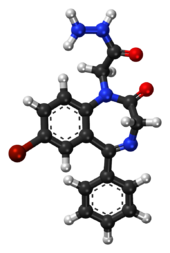
KNOWPIA
WELCOME TO KNOWPIA
Summary
Gidazepam, also known as hydazepam or hidazepam,[1] is a drug which is an atypical benzodiazepine derivative, developed in the Soviet Union.[2][3] It is a selectively anxiolytic benzodiazepine.[4] It also has therapeutic value in the management of certain cardiovascular disorders.[5][6][7][8][9]
 | |
 | |
| Clinical data | |
|---|---|
| Trade names | Gidazepam IC |
| Routes of administration | Oral |
| Legal status | |
| Legal status |
|
| Pharmacokinetic data | |
| Metabolism | Hepatic |
| Elimination half-life | ~87 hours |
| Excretion | Renal |
| Identifiers | |
| |
| CAS Number |
|
| PubChem CID |
|
| DrugBank |
|
| ChemSpider |
|
| UNII |
|
| CompTox Dashboard (EPA) |
|
| Chemical and physical data | |
| Formula | C17H15BrN4O2 |
| Molar mass | 387.237 g·mol−1 |
| 3D model (JSmol) |
|
| |
| |
| | |
Gidazepam is a prodrug for its active metabolite 7-bromo-2,3-dihydro-5-phenyl-1H-1,4-benzodiazepin-2-one (desalkylgidazepam or bromo-nordazepam).[10][11] It is used as an antianxiety drug. Its anxiolytic effects can take several hours to manifest after dosing however, as it is the active metabolite which primarily gives the anxiolytic effects, and Gidazepam's half-life is among the longest of all benzodiazepines.[12]

See also edit
- Phenazepam—another benzodiazepine widely used in Russia and other CIS countries
- Cinazepam
- Cloxazolam
References edit
- ^ Library of Congress (2006). Library of Congress Subject Headings. Library of Congress. pp. 3300–.
- ^ Spasennikov BA, Spasennikova MG (September 1991). "[The new Soviet tranquilizer--gidazepam]". Fel'dsher I Akusherka. 56 (9): 35–7. PMID 1684941.
- ^ Neznamov GG, Koshelev VV, Voronina TA, Trofimov SS (Mar 2002). "[Experimental and clinical rationale for complex treatment of mental disorders in clean-up workers of the Chernobyl nuclear plant accident]". Eksperimental'naia i Klinicheskaia Farmakologiia. 65 (2): 12–6. PMID 12109283.
- ^ Korkhov VM, Tkachuk NA, Makan SY, Pavlovsky VI, Andronati SA (Feb 2002). "Affinities of gidazepam and its analogs for mitochondrial benzodiazepine receptors". Journal of Receptor and Signal Transduction Research. 22 (1–4): 411–20. doi:10.1081/RRS-120014610. PMID 12503630. S2CID 25403613.
- ^ Morozov IS, Barchukov VG, Neznamov GG (Jan 1998). "[The effect of gidazepam on the cardiovascular system function in patients with neurotic reactions and in healthy subjects under aggravated conditions]". Eksperimental'naia i Klinicheskaia Farmakologiia. 61 (1): 30–2. PMID 9575408.
- ^ Petrova TR, Tatarkin AN (1994). "[The neuroregulatory modulation of the hemodynamic reactions to physical loading in patients with cardiac arrhythmias]". Terapevticheskii Arkhiv. 66 (9): 65–8. PMID 7992218.
- ^ Skibitskiĭ VV, Kanorskiĭ SG (Sep 1993). "[New pharmacodynamic effects of gidazepam and befol in patients with cardiac arrhythmias]". Eksperimental'naia i Klinicheskaia Farmakologiia. 56 (5): 23–7. PMID 7906171.
- ^ Skibitskiĭ VV, Petrova TR, Kanorskiĭ SG (June 1992). "[Comparative analysis of antiarrhythmic action and electrophysiological effects of a new benzodiazepine derivative gidazepam and ethacizin in arrhythmias of various genesis]". Kardiologiia. 32 (6): 35–7. PMID 1405290.
- ^ Meerson FZ, Skibitskiĭ VV (April 1992). "[Comparative anti-arrhythmia effectiveness of activators of body stress-limiting systems in patients with arrhythmia]". Kardiologiia. 32 (4): 25–30. PMID 1328745.
- ^ Andronati SA, Zin'kovskiĭ VG, Totrova MI, Golovenko NI, Stankevich EA, Zhuk OV (January 1992). "[Biokinetics of a new prodrug gidazepam and its metabolite]". Biulleten' Eksperimental'noi Biologii I Meditsiny. 113 (1): 45–7. PMID 1356504.
- ^ Kolyvanov GB, Zherdev VP, Chirkov AM, Otabekova SG, Litvin AA (May 1993). "[Gidazepam biotransformation and pharmacokinetics in different species of animals and man]". Eksperimental'naia i Klinicheskaia Farmakologiia. 56 (3): 48–50. PMID 8106054.
- ^ Zherdev VP, Neznamov GG, Kolyvanov GB, Litvin AA, Otabekova SG (May 1993). "[The pharmacokinetic aspects of the clinical action of gidazepam]". Eksperimental'naia i Klinicheskaia Farmakologiia. 56 (3): 50–2. PMID 8106055.


